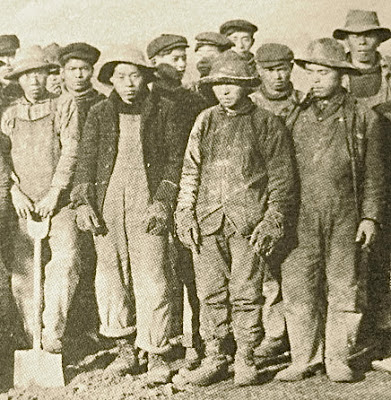Don’t mess with the navvies
Many years ago for Christmas my older son compiled some of my favourite songs onto a CD. "Canadian Railroad Trilogy" by Gord Lightfoot starts it off, and because the CD is in my workshop and this is birdhouse-building season, I listen to the song almost everyday. I never tire of it. After a ‘shed night’ (def.: when friends and I sip ‘Pepsis’ for an hour or two in my shop) I’ll listen to it, sometimes repeatedly, while I put chairs away and sweep peanuts off the floor.
Here are some of my favourite lines:
We are the navvies who work upon the railway
Swinging our hammers in the bright blazing sun
Living on stew and drinking bad whiskey
Bending our backs til the long days are done.
Swinging our hammers in the bright blazing sun
Living on stew and drinking bad whiskey
Bending our backs til the long days are done.
We are the navvies who work upon the railway
Swinging our hammers in the bright blazing sun
Laying down track and building the bridges
Bending our backs til the railroad is done.
Swinging our hammers in the bright blazing sun
Laying down track and building the bridges
Bending our backs til the railroad is done.
(Listen to the full 1967 version here)
In my mind it is a magnificent song from beginning to end. It takes me across Canada upon iron rails and a fine melody. And all along the way I see and hear and feel the work done by the navvies with their heavy, swingin’ hammers.
At wikipedia I read the following:
The "Canadian Railroad Trilogy" is a song by Gordon Lightfoot that describes the building of the Canadian Pacific Railway. This song was commissioned by the CBC for a special broadcast on January 1, 1967, to start Canada's Centennial year... In the first section, the song picks up speed like a locomotive building up a head of steam.
While Lightfoot's song echoes the optimism of the railroad age, it also chronicles the cost in sweat and blood of building "an iron road runnin' from the sea to the sea." The slow middle section of the song is especially poignant, vividly describing the efforts and sorrows of the nameless and forgotten navvies whose manual labour actually built the railway. (Wikipedia)
[“Canadian Prairies fly by, April 2012”: Photo by GH]
[“Sunset on the Prairies”: Photo by GH]
And who are the navvies? Here is what I know.
In my own experience I’ve only come across the word once in the many books I’ve read over my lifetime, and I discovered it recently (thus the posts about it) in a book entitled ‘The Day We Went to War’.
I read the following:
Those in the civilian army of the Air Raid Precautions responsible for enforcing the blackout, especially air-raid wardens with their cry ‘Put that light out!’, soon became targets for the public’s pent-up fury and frustration (e.g., re black-outs... A Bradford navvy was of the opinion that ‘Three quid a week’s too much for just playing cards and such-like for them buggers... And if they say they’ve homes to keep and they’ve themselves to feed, I’d make them live in barracks.’ (pg. 334 - 335)
Well, there you go. Don’t mess with the navvies, eh.
More information isn’t hard to find.
For example:
A "navvy" depicted in Ford Madox Brown’s painting ‘Work Navvy’ is a shorter form of navigator (UK) or navigational engineer (USA) and is particularly applied to describe the manual labourers working on major civil engineering projects. The term was coined in the late 18th century in Britain when numerous canals were being built, which were also sometimes known as "navigations", or "eternal navigations", intended to last forever. (wikipedia.org http://en.wikipedia.org/wiki/Navvy)
[“We are the navvies... swingin’ our hammers”: Canadian Encyclopedia]
As well, the Canadian Encyclopedia serves as another source of information about navvies:
Almost every leading figure connected with the building of the CPR has been immortalized in a Canadian place-name... The top dogs had mountain peaks named for them or in the case of Cornelius Van Horne, a whole mountain range. But what about the men who actually built the railway? Where are their names recorded, except on tombstones along the way?
The railway navvies were a mixed lot. Charles Peyton who walked down one stretch of track looking for work saw a band of Italians at one spot and a team of Englishmen a few kilometers later. He met a scholar who could speak and write Greek, a surgeon from Montreal and a pastor from Chicago. Generally, though, Peyton found the men to be a rough lot with ill manners and disagreeable mouths. They were there for the $2.00 to $2.50 a day, which was good pay for the time. [The Canadian Encyclopedia]
And yesterday a friend dropped off - unbeknownst to him, in such a timely fashion - a copy of The Rocky Mountaineer Mile Post. I quickly learned that some navvies (from China, by way of the USA) worked for half price and worked in extremely dangerous conditions, as can be seen in the last line of the highlighted paragraph below.
The last line of Lightfoot’s song pays tribute to the navvies, and, as of yet, I don’t know of another song that does.
"Canadian Railroad Trilogy" is in ‘Gord’s Top Ten’ for many reasons, and now you know some of them.
[“Sunset on the Prairies”: Photo by GH]
***
Perhaps you know of another song that mentions the navvies. Please let me know.
Please click here to read another short story
.







No comments:
Post a Comment